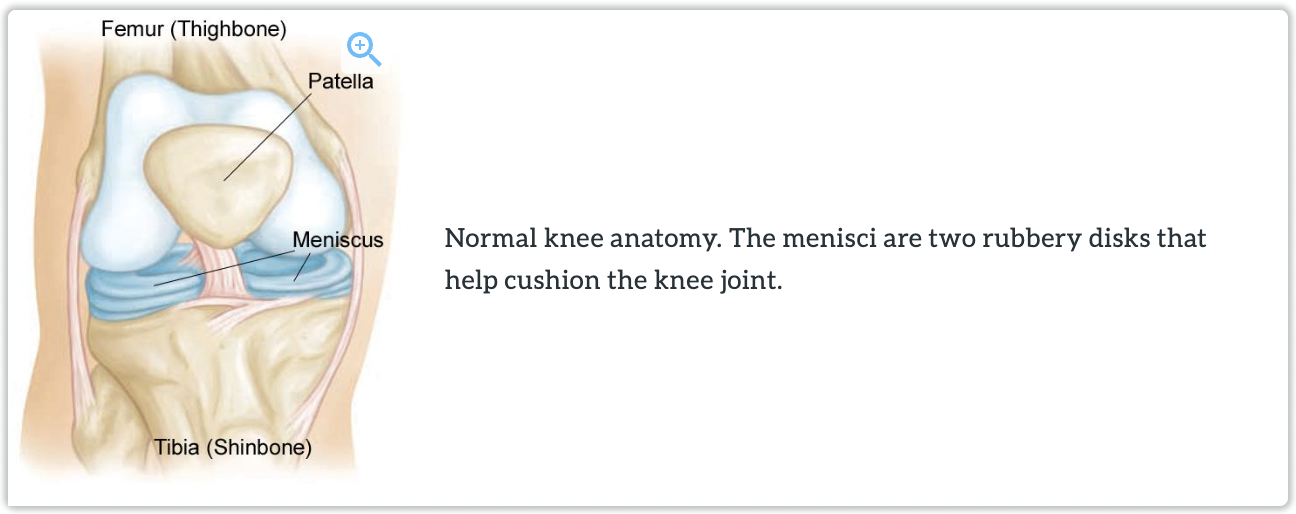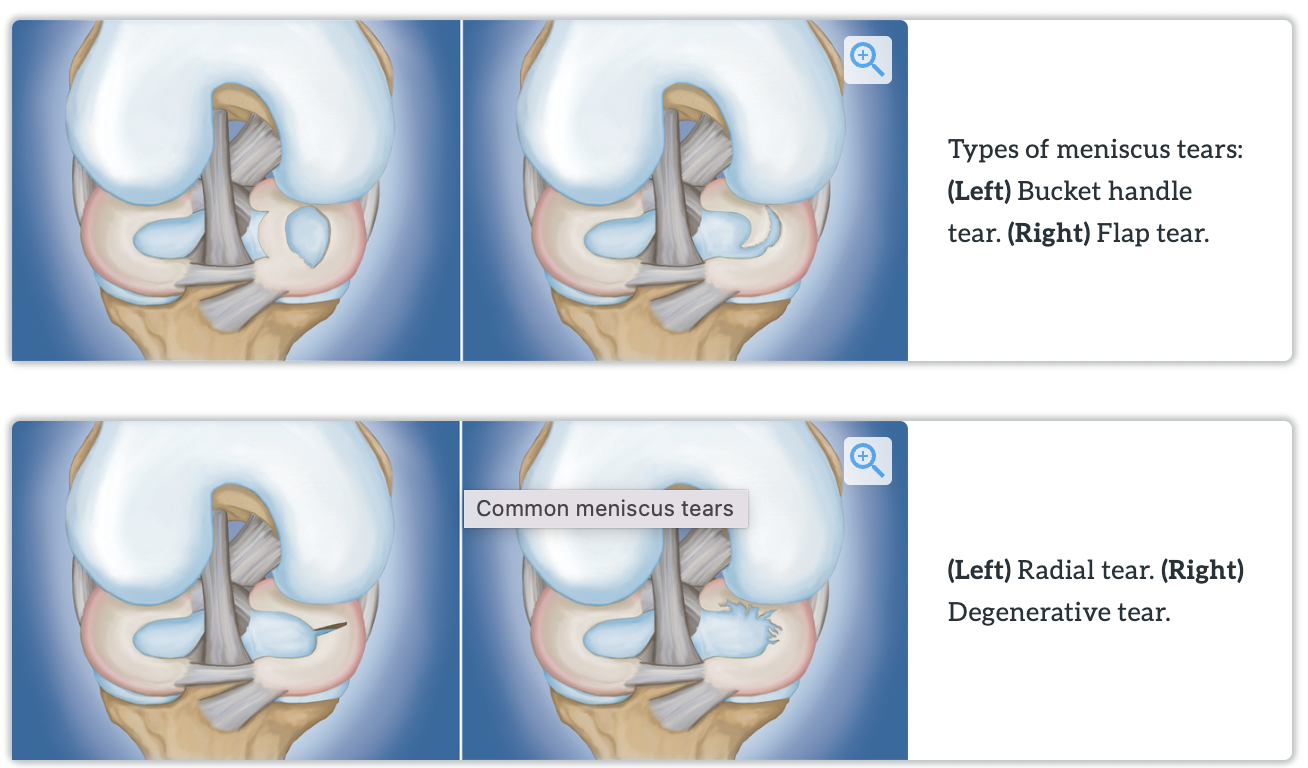Northern California Meniscus Tear Treatment
What is a Meniscus Tear?
Meniscus tears commonly occur when the knee is suddenly twisted or turned while bent and the foot is planted on the ground. Tears may also happen when kneeling, squatting, or lifting something heavy. The normal wear-and-tear of aging on cartilage may also make it easier for the menisci to tear.
Meniscus tears are categorized into three groups: minor, moderate, and severe.
Anatomy
Two bones meet to form your knee joint: the femur and the tibia. The kneecap (patella) sits in front of the joint to provide some protection.
Two wedge-shaped pieces of fibrocartilage act as shock absorbers between your femur and tibia. These are the menisci. The menisci help to transmit weight from one bone to another and play an important role in knee stability.

The meniscus can tear from acute trauma or as the result of degenerative changes that happen over time. Tears are noted by how they look, as well as where the tear occurs in the meniscus. Common tears include bucket handle, flap, and radial.
Sports-related meniscus injuries often occur along with other knee injuries, such as anterior cruciate ligament (ACL) tears.

Symptoms of Meniscus Tears
Symptoms of a meniscus tear depend on the severity of the injury. The symptoms of a minor tear are mild pain and swelling.
A moderate tear may develop more swelling over the course of a few days, and sharp pain may occur when squatting or twisting the knee. In a moderate tear, the pain is typically felt on the side or the center of the knee and may come and go on its own for years if the tear is not properly treated.
After a severe tear, pieces of the torn disc interfere with joint function, causing the knee to catch, pop, lock, or be difficult to straighten. In addition to swelling and stiffness, the knee may feel unstable or give way unexpectedly.
Doctor Examination
Physical Examination
After discussing your symptoms and medical history, your doctor will examine your knee. They will check for tenderness along the joint line where the meniscus sits. This often signals a tear.
One of the main tests for meniscus tears is the McMurray test. Your doctor will bend your knee, then straighten and rotate it. This puts tension on a torn meniscus. If you have a meniscus tear, this movement may cause pain, clicking, or a clunking sensation within the joint.
Imaging Tests
Because other knee injuries can cause similar symptoms, your doctor may order imaging tests to help confirm the diagnosis.
X-rays. X-rays provide images of dense structures, such as bone. Although an X-ray will not show a meniscus tear, your doctor may order one to look for other causes of knee pain, such as osteoarthritis.
Magnetic resonance imaging (MRI) scans. An MRI scan assesses the soft tissues in your knee joint, including the menisci, cartilage, tendons, and ligaments.
Treatment of Meniscus Tears
Treatment for meniscus tears should include rest, ice, compression of the knee with an elastic bandage, and elevation of the affected leg. Physical therapy exercises may also be helpful or necessary to regain function.
Treatment options for more severe tears may depend on the location of the tear and the age of the injured person. Large tears near the outside of the knee may improve with surgery.
Surgery may be less effective at repairing large tears near the center of the knee, but for a younger person, the benefit of restoring the knee’s function may make surgery a worthwhile option.
Nonsurgical Treatment
Many meniscus tears will not need immediate surgery. If your symptoms do not persist and you have no locking or swelling of the knee, your doctor may recommend nonsurgical treatment.
RICE. The RICE protocol is effective for most sports-related injuries. RICE stands for Rest, Ice, Compression, and Elevation.
- Rest. Take a break from the activity that caused the injury. Your doctor may recommend that you use crutches to avoid putting weight on your leg.
- Ice. Use cold packs for 20 minutes at a time, several times a day. Do not apply ice directly to the skin.
- Compression. To prevent additional swelling and blood loss, wear an elastic compression bandage.
- Elevation. To reduce swelling, recline when you rest, and put your leg up higher than your heart.
Surgical Treatment
If your symptoms persist with nonsurgical treatment, your doctor may suggest arthroscopic surgery.
Procedure. Knee arthroscopy is one of the most commonly performed surgical procedures. In this procedure, the surgeon inserts a miniature camera through a small incision (portal) in the knee. This provides a clear view of the inside of the knee. The surgeon then inserts surgical instruments through two or three other small portals to trim or repair the tear.
- Partial meniscectomy. In this procedure, the damaged meniscus tissue is trimmed away. This procedure typically allows for immediate weight bearing, and full range of motion soon after surgery.
- Meniscus repair. Some meniscus tears can be repaired by suturing (stitching) the torn pieces together. Whether a tear can be successfully repaired depends upon the type of tear, as well as the overall condition of the injured meniscus. Because the meniscus must heal back together, recovery time for a repair is longer than for a meniscectomy.
Once the initial healing is complete, your doctor will prescribe rehabilitation exercises. Regular exercise to restore your knee mobility and strength is necessary. You will start with exercises to improve your range of motion. Strengthening exercises will gradually be added to your rehabilitation plan.
In many cases, rehabilitation can be carried out at home, although your doctor may recommend working with a physical therapist. Rehabilitation time for a meniscus repair is about 3 to 6 months. A meniscectomy requires less time for healing — approximately 3 to 6 weeks.
Recovery
Meniscus tears are extremely common knee injuries. With proper diagnosis, treatment, and rehabilitation, patients often return to their pre-injury abilities.
Patients Success Stories:
“Dr. Wong is the best and I’ll be back to her for the other hip when it is time for that to be done. Five stars!”
“My care was exceptional and my pain was immediately gone.”
“I can never say enough about how much better I am.”
“I’m a lifelong patient of Dr. Roth now! He made it a very good experience. I woke up a little dazed, but with no pain, and there’s no scar.”
